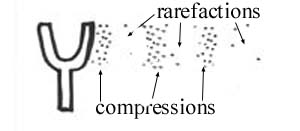
If we look at a tuning fork vibrating back and forth, we see that it has areas of high pressure (compressions) and low pressure (rarefactions) continuously forming and moving away from it. This is what we know as sound. How do these form?

1. You strike the fork and the arms bend in. They have elastic
potential energy at this point:

2. The arms spring out, compressing the air immediately next to
them. Only the air on one side is shown for clarity here:

3. Having sprung out a bit farther than is stable for the metal in the
tuning fork, the arms spring back in, creating an area of low pressure
right next to the tuning fork. Meanwhile, the molecules in the region
of high pressure have banged into the ones next to them, and the compression
has moved on:

4. The arms spring out again, creating a new compression:

5. The arms spring in again, with a new rarefaction forming right
next to them:

6. The arms spring out again, creating a new compression; the
other compressions have moved on as before:

©2006 Jeff Goodman
Back to ASU Elementary School Science Home Page
©2001 Jeff Goodman
Back to ASU Science and Science Teaching in the Elementary School Home Page